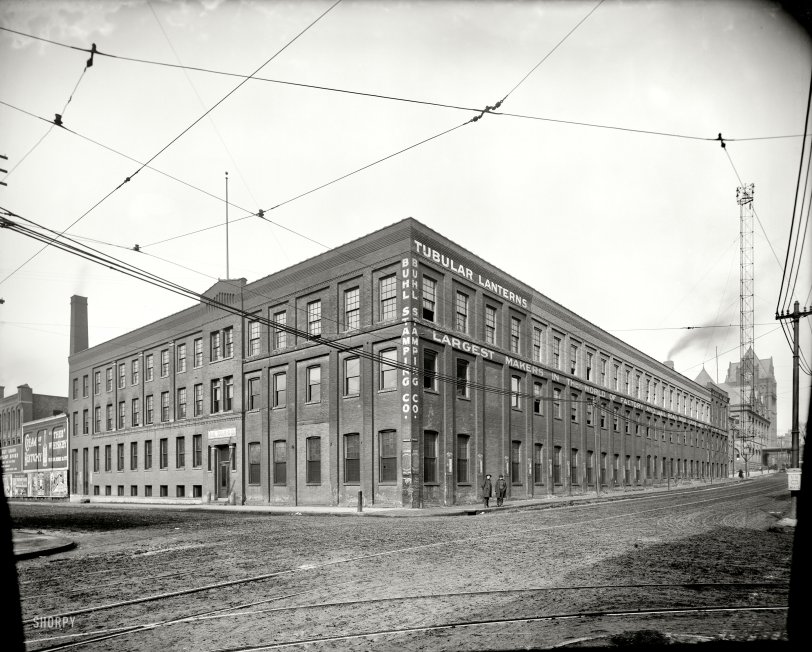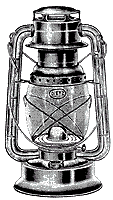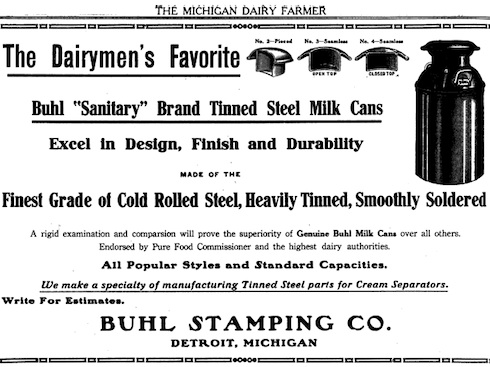


Framed or unframed, desk size to sofa size, printed by us in Arizona and Alabama since 2007. Explore now.
Shorpy is funded by you. Patreon contributors get an ad-free experience.
Learn more.

- Freeze Frame
- Texas Flyer wanted
- Just a Year Too Soon
- WWII -- Replacing men with women at the railroad crossing.
- Yes, Icing
- You kids drive me nuts!
- NOT An Easy Job
- I wonder
- Just add window boxes
- Icing Platform?
- Indiana Harbor Belt abides
- Freezing haze
- Corrections (for those who care)
- C&NW at Nelson
- Fallen Flags
- A dangerous job made worse
- Water Stop
- Passenger trains have right of way over freights?
- Coal
- Never ceases to amaze me.
- Still chuggin' (in model form)
- Great shot
- Westerly Breeze
- For the men, a trapeze
- Tickled
- Sense of loneliness ...
- 2 cents
- Charm City
- What an Outrage
- Brighton Park
Print Emporium
Tubular Lanterns: 1905

Detroit circa 1905. "Buhl Stamping Co., 3rd Ave. and Larned." Note the "Cheese Factory" milk cans illustrated between the windows, and the arc-lamp "moonlight tower" to the right. 8x10 glass negative, Detroit Publishing Co. View full size.
Fort Street Depot
Al, your command of the history of Detroit is amazing. One thing I never realized, even though I have looked at both buildings dozens of times, was the similarity between the Fort Street Depot and Old Main (for those unfamiliar - old Central High now part of Wayne State).
I see there is a plug for the Evening News on the side of the building next door too.
Not to be confused with RR lamps
 Tubular lanterns are characterized by vertical tubes that flank the globe, as shown by the illustration at right. Although one line of railroad lanterns, the Dietz "Vesta", used this design, the vast majority of tubular lanterns were manufactured for general domestic, farm, and industrial purposes. There were many variations on this general style using both the "hot blast" and "cold blast" combustion design. Many different manufacturers, including R.E. Dietz, Embury, and C.T. Ham, produced tubular lanterns, and some production continues to this day for domestic and specialty markets.
Tubular lanterns are characterized by vertical tubes that flank the globe, as shown by the illustration at right. Although one line of railroad lanterns, the Dietz "Vesta", used this design, the vast majority of tubular lanterns were manufactured for general domestic, farm, and industrial purposes. There were many variations on this general style using both the "hot blast" and "cold blast" combustion design. Many different manufacturers, including R.E. Dietz, Embury, and C.T. Ham, produced tubular lanterns, and some production continues to this day for domestic and specialty markets.
Tubular lanterns are frequently misidentified as railroad lanterns.
Buhl Tinning Plant
Iron and Steel Works of the United States, 1910.Tinplates and Terne Plates.
Michigan
Buhl Stamping Company, Detroit. Tinning plant erected in 1888; product, tinplates, all consumed by the company in the manufacture of milk-can stock, tubular lanterns, etc. A galvanizing plant is connected with the works. Fuel, coal. Buys back plates.
The World Almanac & Encyclopedia, 1901,
The Press Publishing Co., NY.Perfect Milk Cans are essential to profitable dairying. A Milk Can is not perfect unless it can be kept absolutely clean and free from germs and unless it will last five or ten years without repairs.
The highest award at the Paris Exposition of 1900 was granted to the Buhl Cans on these two points, Buhl Cans have the patented "Victor" Can Breast, smooth as glass and free from spinning marks.
Buhl Cans have no crevices within where milk can lodge, and sour, and smell.
Buhl Cans are perfectly tinned and free from blemish of any kind.
Buhl Cans are heavily and smoothly soldered within and without and every can is tested.
Buhl Cans will not break, leak, or rust like common cans.
Buhl Cans are indorsed by the highest dairy authorities for their cleanliness and great durability. They are used by the United States Government and the largest creameries in the country.
They cost a little more than other cans, but will last twice as long without repairs, and are easier to clean.
If these points appeal to you, send for our book of
testimonials "From Mexico to the Top of the Earth,"
and price list.We caution can buyers against imitation Buhl Cans
offered by some supply houses. Every genuine Buhl
Can bears our labels, and is stamped with the Milk
Can Trademark.It is a pleasure to answer inquiries in regard to
these goods. Send your order direct to the makers.BUHL STAMPING COMPANY,
Cor. Third and Larned Sts., Detroit, Mich.Sufficient capacity to make every Milk Can used in the
United States.

Canned
All of the buildings in this picture are long gone. I'm in my early 50s, and am just old enough to remember using the Fort Street depot. The depot was a truly beautiful Richardsonesque red sandstone building with a large blocky clock tower that loomed over Fort Street for over 80 years.
These buildings were replaced by Wayne County Community College, its parking lot, and the Lodge Freeway. Although their domination over the milk can business has long since faded away, the Buhl family remains one of the Detroit area's most prominent families, with one of downtown Detroit's most beautiful skyscrapers named for them.
Rough Road?
What is the road surface made of? Is it brick that just has dirt and perhaps "wintertime" stuff on it? Or is it actually a dirt road. I've seen this in other pictures and have wondered.
[Brick pavers are probably somewhere under there. - Dave]
Relatively new building
Architecturally, I'd guess that's a fairly new building. It has pretty simple/plain lines, and more importantly it's probably using iron or steel window headers (rather than brick arches as was used in older buildings.) Compare to the building on the left, where there are those arches above the windows. (Still, I'm not sure if those arches are decorative or structural.)
What's the building to the right? It's much fancier, and could be a post office, courthouse or railroad station. I'd guess the latter, just because this plant needs rail service presumably going into the back of the structure (raw materials in, finished milk cans out.)
[That's the Fort Street Union Depot. - Dave]
























On Shorpy:
Today’s Top 5